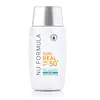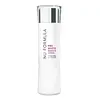What's inside
What's inside
 Key Ingredients
Key Ingredients

 Benefits
Benefits

 Concerns
Concerns

 Ingredients Side-by-side
Ingredients Side-by-side

Cyclopentasiloxane
EmollientWater
Skin ConditioningZinc Oxide
Cosmetic ColorantAlcohol Denat.
AntimicrobialEthylhexyl Methoxycinnamate
UV AbsorberDimethicone
EmollientIsododecane
EmollientPolymethyl Methacrylate
Silica
AbrasiveBis-Ethylhexyloxyphenol Methoxyphenyl Triazine
Skin ConditioningEthylhexyl Salicylate
UV AbsorberPEG-10 Dimethicone
Skin ConditioningTalc
AbrasiveButylene Glycol
HumectantC12-15 Alkyl Benzoate
AntimicrobialEthylhexyl Triazone
UV AbsorberPolymethylsilsesquioxane
Hydrolyzed Jojoba Esters
Skin ConditioningCetyl PEG/PPG-10/1 Dimethicone
EmulsifyingPhenoxyethanol
PreservativeSodium Chloride
MaskingDimethicone/Vinyltrimethylsiloxysilicate Crosspolymer
Methicone
EmollientGlycerin
HumectantDextrin Palmitate
EmulsifyingPolysilicone-11
Chlorphenesin
AntimicrobialTocopheryl Acetate
AntioxidantDipotassium Glycyrrhizate
HumectantDisodium EDTA
Polysorbate 40
EmulsifyingHydrogen Dimethicone
Palmitic Acid
EmollientNiacinamide
SmoothingZinc PCA
HumectantSodium Hyaluronate
HumectantTerminalia Ferdinandiana Fruit Extract
AntioxidantMelanin
Skin Protecting1,2-Hexanediol
Skin ConditioningPentylene Glycol
Skin ConditioningBiosaccharide Gum-4
Skin ConditioningEthylhexylglycerin
Skin ConditioningCyclopentasiloxane, Water, Zinc Oxide, Alcohol Denat., Ethylhexyl Methoxycinnamate, Dimethicone, Isododecane, Polymethyl Methacrylate, Silica, Bis-Ethylhexyloxyphenol Methoxyphenyl Triazine, Ethylhexyl Salicylate, PEG-10 Dimethicone, Talc, Butylene Glycol, C12-15 Alkyl Benzoate, Ethylhexyl Triazone, Polymethylsilsesquioxane, Hydrolyzed Jojoba Esters, Cetyl PEG/PPG-10/1 Dimethicone, Phenoxyethanol, Sodium Chloride, Dimethicone/Vinyltrimethylsiloxysilicate Crosspolymer, Methicone, Glycerin, Dextrin Palmitate, Polysilicone-11, Chlorphenesin, Tocopheryl Acetate, Dipotassium Glycyrrhizate, Disodium EDTA, Polysorbate 40, Hydrogen Dimethicone, Palmitic Acid, Niacinamide, Zinc PCA, Sodium Hyaluronate, Terminalia Ferdinandiana Fruit Extract, Melanin, 1,2-Hexanediol, Pentylene Glycol, Biosaccharide Gum-4, Ethylhexylglycerin
Water
Skin ConditioningButylene Glycol
HumectantPropylene Glycol
HumectantPropanediol
SolventPEG/PPG-17/6 Copolymer
SolventPhenoxyethanol
PreservativeGlycerin
HumectantTrehalose
HumectantPolysorbate 20
EmulsifyingChlorphenesin
AntimicrobialCarbomer
Emulsion StabilisingNiacinamide
SmoothingDisodium EDTA
Sodium Hydroxide
BufferingBenzotriazolyl Dodecyl P-Cresol
UV AbsorberTris(Tetramethylhydroxypiperidinol) Citrate
UV Absorber1,2-Hexanediol
Skin ConditioningSodium Citrate
Buffering3-O-Ethyl Ascorbic Acid
Skin ConditioningTranexamic Acid
AstringentPanthenol
Skin ConditioningCystoseira Tamariscifolia Extract
Skin ConditioningCitrus Reticulata Peel Extract
Skin ConditioningXanthan Gum
EmulsifyingZinc PCA
HumectantTocopheryl Acetate
AntioxidantAllantoin
Skin ConditioningAlpha-Arbutin
AntioxidantCentella Asiatica Extract
CleansingAloe Barbadensis Leaf Extract
EmollientEthylhexylglycerin
Skin ConditioningCaprylyl Glycol
EmollientLeontopodium Alpinum Extract
Skin ConditioningGlycyrrhiza Glabra Root Extract
BleachingHibiscus Sabdariffa Flower Extract
Skin ConditioningGlucose
HumectantMagnesium PCA
HumectantSodium Lactate
BufferingSodium Hyaluronate
HumectantCopper Tripeptide-1
Skin ConditioningGlutathione
Potassium Sorbate
PreservativeSodium Benzoate
MaskingChondrus Crispus Extract
Skin ConditioningSerine
MaskingSucrose
HumectantUrea
BufferingGlycine
BufferingCalcium Chloride
AstringentPotassium Hydroxide
BufferingOrnithine
Skin ConditioningMaris Sal
Skin ConditioningAlanine
MaskingMagnesium Chloride
Hydroxypropyltrimonium Hyaluronate
Threonine
Histidine
HumectantAspartic Acid
MaskingValine
MaskingProline
Skin ConditioningDipotassium Phosphate
BufferingLysine
Skin ConditioningLeucine
Skin ConditioningTyrosine
MaskingIsoleucine
Skin ConditioningMagnesium Citrate
Skin ConditioningGlucosamine Hcl
Phenylalanine
MaskingGlutamic Acid
HumectantArginine
Masking1-Methylhydantoin-2-Imide
Skin ConditioningAsparagine
MaskingCitrulline
Skin ConditioningUric Acid
BufferingMethionine
Skin ConditioningTaurine
BufferingHydrolyzed Hyaluronic Acid
HumectantSodium Acetylated Hyaluronate
HumectantTryptophan
MaskingFormic Acid
PreservativeAmmonia
BufferingGlutamine
Skin ConditioningCysteine
AntioxidantHyaluronic Acid
HumectantSodium Hyaluronate Crosspolymer
HumectantHydrolyzed Sodium Hyaluronate
Skin ConditioningPotassium Hyaluronate
Skin ConditioningWater, Butylene Glycol, Propylene Glycol, Propanediol, PEG/PPG-17/6 Copolymer, Phenoxyethanol, Glycerin, Trehalose, Polysorbate 20, Chlorphenesin, Carbomer, Niacinamide, Disodium EDTA, Sodium Hydroxide, Benzotriazolyl Dodecyl P-Cresol, Tris(Tetramethylhydroxypiperidinol) Citrate, 1,2-Hexanediol, Sodium Citrate, 3-O-Ethyl Ascorbic Acid, Tranexamic Acid, Panthenol, Cystoseira Tamariscifolia Extract, Citrus Reticulata Peel Extract, Xanthan Gum, Zinc PCA, Tocopheryl Acetate, Allantoin, Alpha-Arbutin, Centella Asiatica Extract, Aloe Barbadensis Leaf Extract, Ethylhexylglycerin, Caprylyl Glycol, Leontopodium Alpinum Extract, Glycyrrhiza Glabra Root Extract, Hibiscus Sabdariffa Flower Extract, Glucose, Magnesium PCA, Sodium Lactate, Sodium Hyaluronate, Copper Tripeptide-1, Glutathione, Potassium Sorbate, Sodium Benzoate, Chondrus Crispus Extract, Serine, Sucrose, Urea, Glycine, Calcium Chloride, Potassium Hydroxide, Ornithine, Maris Sal, Alanine, Magnesium Chloride, Hydroxypropyltrimonium Hyaluronate, Threonine, Histidine, Aspartic Acid, Valine, Proline, Dipotassium Phosphate, Lysine, Leucine, Tyrosine, Isoleucine, Magnesium Citrate, Glucosamine Hcl, Phenylalanine, Glutamic Acid, Arginine, 1-Methylhydantoin-2-Imide, Asparagine, Citrulline, Uric Acid, Methionine, Taurine, Hydrolyzed Hyaluronic Acid, Sodium Acetylated Hyaluronate, Tryptophan, Formic Acid, Ammonia, Glutamine, Cysteine, Hyaluronic Acid, Sodium Hyaluronate Crosspolymer, Hydrolyzed Sodium Hyaluronate, Potassium Hyaluronate
Ingredients Explained
These ingredients are found in both products.
Ingredients higher up in an ingredient list are typically present in a larger amount.
1,2-Hexanediol is a synthetic liquid and another multi-functional powerhouse.
It is a:
- Humectant, drawing moisture into the skin
- Emollient, helping to soften skin
- Solvent, dispersing and stabilizing formulas
- Preservative booster, enhancing the antimicrobial activity of other preservatives
Butylene Glycol (or BG) is used within cosmetic products for a few different reasons:
Overall, Butylene Glycol is a safe and well-rounded ingredient that works well with other ingredients.
Though this ingredient works well with most skin types, some people with sensitive skin may experience a reaction such as allergic rashes, closed comedones, or itchiness.
Learn more about Butylene GlycolChlorphenesin is a synthetic preservative. It helps protect a product against bacteria in order to extend shelf life. In most cases, Chlorphenesin is paired with other preservatives such as phenoxyethanol and caprylyl glycol.
Chlorphenesin is a biocide. This means it is able to help fight the microorganisms on our skin. It is also able to fight odor-releasing bacteria.
Chlorphenesin is soluble in both water and glycerin.
Studies show Chlorphenesin is easily absorbed by our skin. You should speak with a skincare professional if you have concerns about using Chlorphenesin.
Learn more about ChlorphenesinDisodium EDTA plays a role in making products more stable by aiding other preservatives.
It is a chelating agent, meaning it neutralizes metal ions that may be found in a product.
Disodium EDTA is a salt of edetic acid and is found to be safe in cosmetic ingredients.
Learn more about Disodium EDTAEthylhexylglycerin (we can't pronounce this either) is commonly used as a preservative and skin softener. It is derived from glyceryl.
You might see Ethylhexylglycerin often paired with other preservatives such as phenoxyethanol. Ethylhexylglycerin has been found to increase the effectiveness of these other preservatives.
Glycerin is already naturally found in your skin. It helps moisturize and protect your skin.
A study from 2016 found glycerin to be more effective as a humectant than AHAs and hyaluronic acid.
As a humectant, it helps the skin stay hydrated by pulling moisture to your skin. The low molecular weight of glycerin allows it to pull moisture into the deeper layers of your skin.
Hydrated skin improves your skin barrier; Your skin barrier helps protect against irritants and bacteria.
Glycerin has also been found to have antimicrobial and antiviral properties. Due to these properties, glycerin is often used in wound and burn treatments.
In cosmetics, glycerin is usually derived from plants such as soybean or palm. However, it can also be sourced from animals, such as tallow or animal fat.
This ingredient is organic, colorless, odorless, and non-toxic.
Glycerin is the name for this ingredient in American English. British English uses Glycerol/Glycerine.
Learn more about GlycerinNiacinamide is a multitasking form of vitamin B3 that strengthens the skin barrier, reduces pores and dark spots, regulates oil, and improves signs of aging.
And the best part? It's gentle and well-tolerated by most skin types, including sensitive and reactive skin.
You might have heard of "niacin flush", or the reddening of skin that causes itchiness. Niacinamide has not been found to cause this.
In very rare cases, some individuals may not be able to tolerate niacinamide at all or experience an allergic reaction to it.
If you are experiencing flaking, irritation, and dryness with this ingredient, be sure to double check all your products as this ingredient can be found in all categories of skincare.
When incorporating niacinamide into your routine, look out for concentration amounts. Typically, 5% niacinamide provides benefits such as fading dark spots. However, if you have sensitive skin, it is better to begin with a smaller concentration.
When you apply niacinamide to your skin, your body converts it into nicotinamide adenine dinucleotide (NAD). NAD is an essential coenzyme that is already found in your cells as "fuel" and powers countless biological processes.
In your skin, NAD helps repair cell damage, produce new healthy cells, support collagen production, strengthen the skin barrier, and fight environmental stressors (like UV and pollution).
Our natural NAD levels start to decline with age, leading to slower skin repair, visible aging, and a weaker skin barrier. By providing your skin niacinamide, you're recharging your skin's NAD levels. This leads to stronger, healthier, and younger looking skin.
Another name for vitamin B3 is nicotinamide. This vitamin is water-soluble and our bodies don't store it. We obtain Vitamin B3 from either food or skincare. Meat, fish, wheat, yeast, and leafy greens contain vitamin B3.
The type of niacinamide used in skincare is synthetically created.
Learn more about NiacinamidePhenoxyethanol is a preservative that has germicide, antimicrobial, and aromatic properties. Studies show that phenoxyethanol can prevent microbial growth. By itself, it has a scent that is similar to that of a rose.
It's often used in formulations along with Caprylyl Glycol to preserve the shelf life of products.
Sodium Hyaluronate is hyaluronic acid's salt form. It is commonly derived from the sodium salt of hyaluronic acid.
Like hyaluronic acid, it is great at holding water and acts as a humectant. This makes it a great skin hydrating ingredient.
Sodium Hyaluronate is naturally occurring in our bodies and is mostly found in eye fluid and joints.
These are some other common types of Hyaluronic Acid:
Learn more about Sodium HyaluronateTocopheryl Acetate is AKA Vitamin E. It is an antioxidant and protects your skin from free radicals. Free radicals damage the skin by breaking down collagen.
One study found using Tocopheryl Acetate with Vitamin C decreased the number of sunburned cells.
Tocopheryl Acetate is commonly found in both skincare and dietary supplements.
Learn more about Tocopheryl AcetateWater. It's the most common cosmetic ingredient of all. You'll usually see it at the top of ingredient lists, meaning that it makes up the largest part of the product.
So why is it so popular? Water most often acts as a solvent - this means that it helps dissolve other ingredients into the formulation.
You'll also recognize water as that liquid we all need to stay alive. If you see this, drink a glass of water. Stay hydrated!
Learn more about WaterZinc PCA (or "zinc salt") differs slightly from zinc itself. PCA stands for pyrrolidone carboxylic acid. However, Zinc PCA comes from zinc.
It can help reduce redness, regulate sebum, and promote the general healing process of the skin.
Zinc PCA tends to be especially useful for those with oily, acne-prone skin. It's certainly an ingredient worth trying out!
Learn more about Zinc PCA